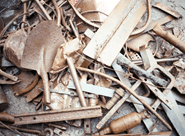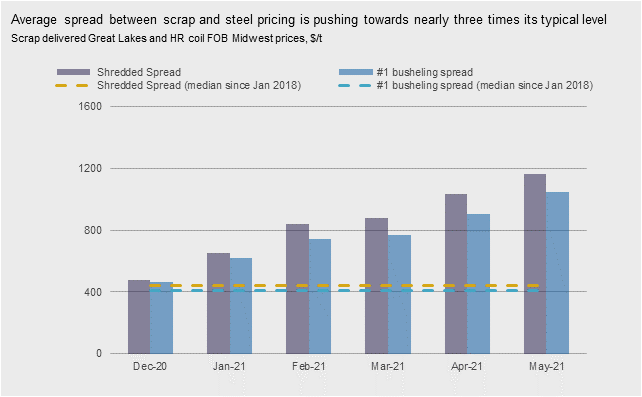Scrap Prices North America

Ferrous Scrap Prices Up in May as Mills Modify Their Mix
Written by Tim Triplett
April 27, 2021
With trading for May not quite finished this week, ferrous scrap prices appeared surprisingly strong, with obsolete grades up about $20/GT and prime grades moving sideways.
Steel Market Update sources put the May price for shred in the range of $450-460 per gross ton, busheling at $590-600 per gross ton, and P/S at $440-445 per gross ton. One source reports prime grades slightly lower at $565-585 per gross ton, depending on the region and the mill.
“Strong demand continues to push scrap prices up in May,” said a dealer in the Northeast. “Mills are trying to reduce the cost of raw material mixes by reducing primes and substituting with lesser-priced grades such as shred and plate. The result is—not surprisingly—higher prices for shred and plate, which is what we are seeing for May.”
“Looking forward,” he added, “we will see continued increasing demand for all ferrous scrap grades domestically combined with a red-hot export market. Scrap prices should enjoy a run of higher prices for the foreseeable future.”
The ferrous scrap market in May is beginning to resemble the strong market it supplies to a small degree, agreed another SMU source. “At the beginning of this week, sentiment was for a decidedly sideways market, even after a $13 bump in the export market at the end of last week. The mills’ narrative was that despite the slightly stronger export market, supply and demand were relatively in balance. But mills’ melt programs have been calling for more shred due to the large price premium that prime commands, and when they began to try to lock down tons for May, some mills found themselves coming up short. Then Delta came out bidding +$20/GT for shred (a return to March levels) and sideways on prime, and was able to buy scrap. Most other mills began to fill in at those levels.”
And the export market continues to rise. Export saw a $25 bump on Wednesday with the latest sale around $475/MT CIF Turkey, he said. “And many observers think that market is not finished rising. Demand both in Turkey and for Turkish steel in Asia is very strong.”
He added: “At this point, even with trading not yet finished for May, the signs are pointing to no worse than a sideways market for June, with a good possibility that it rises again, all despite several scheduled mill outages. Prime supply remains tight with less auto production happening. And with export poised to remain strong, obsolete supply will not be overwhelming.”
“The real story is that mills in the U.S. got off easy by going up only $20/GT in the face of extreme increases in the Turkish market during the last several days,” commented another scrap exec. “Maybe the U.S. market has decoupled from Europe, but I have to believe going forward this rise will affect prices here. The CFR prices for 80/20 into Turkey have risen a bit over $50/MT in the last week or so. Shredded scrap is selling there for $498/MT (not including uploading and inland transportation costs). Here it is $460/MT delivered to the mill. Yes, I’d say U.S. buyers got off cheap.”
Offering some additional context for scrap, CRU Senior Analyst Ryan McKinley noted that mill demand for scrap remains very elevated given long lead times and high prices for finished steel. The return of China on Thursday from its labor day holiday—having removed a VAT rebate of 13% for steel exporters on May 1—has boosted steel and its related markets once again, allowing for an increase in Turkish scrap prices given the attractiveness of its steel in Asian markets. Notably, iron ore has hit record-high price levels, and even tested the $200/t price level today. For reference, the average price for iron ore was ~$90/t between 2018 and 2020, and even that price level can be regarded as somewhat high looking a little further back.
“May scrap prices have essentially returned to those we saw in March, but steel prices continue to outpace this rise. In fact, we are quickly moving towards the HR coil/scrap spread expanding to three times its more normal level,” said McKinley. (See the chart below.)

Pig Iron Market
Commented one pig iron expert: “The pig iron situation is a bit puzzling as U.S.-based EAFs are about to make the same mistake as last year. They are trying to outwait the strengthening in pig iron prices. They will need to restock soon, but have spurned offers for low P Russian and Ukrainian material, which don’t seem to be in danger of falling. In years past, these CIS suppliers had to sell their pig iron because they lacked the immediate capability to convert that pig iron into finished steel at a meaningful profit. However, over the years, this has changed as improvements in the cold ends of these mills have enabled them to seize this opportunity. In a steel market like this, they can make much more money by converting their liquid pig iron into steel products than selling it merchant. So, either the U.S. mills pay more or continue to chase higher P grades in Brazil and even now in India. The offers from CIS all exceed $600/MT CFR U.S. ports.”
By Tim Triplett, Tim@SteelMarketUpdate.com

Tim Triplett
Read more from Tim TriplettLatest in Scrap Prices North America

HRC vs. scrap spread widens over $150/ton in March
The HRC vs. prime scrap spread increased again in March.

HRC vs. prime scrap spread increases in February
The price spread between hot-rolled coil (HRC) and prime scrap widened in February ahead of the implementation of President Trump’s tariffs on steel.
HRC vs. prime scrap spread narrows again in January
The price spread between hot-rolled coil (HRC) and prime scrap continued to narrow in January, according to SMU’s most recent pricing data. While SMU’s average HRC price edged down week over week (w/w), it rose compared to a month ago. The January price for busheling also increased from December. Our average HRC price as of […]

HRC vs. prime scrap spread flat in November
The price spread between hot-rolled coil (HRC) and prime scrap remained the same in November as both tags were at the levels seen a month earlier, according to SMU’s most recent pricing data.

HRC vs. busheling spread narrows slightly in October
The price spread between hot-rolled coil (HRC) and prime scrap narrowed marginally in October, according to SMU’s most recent pricing data.
